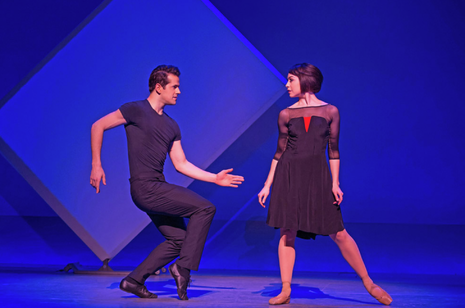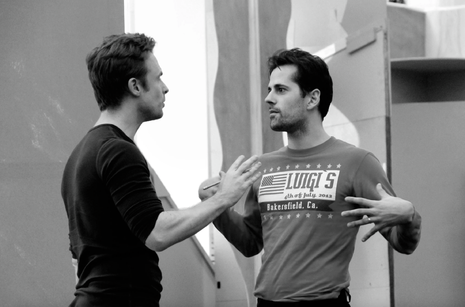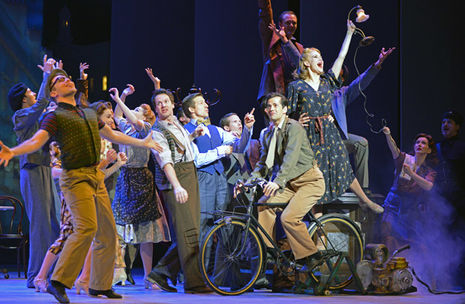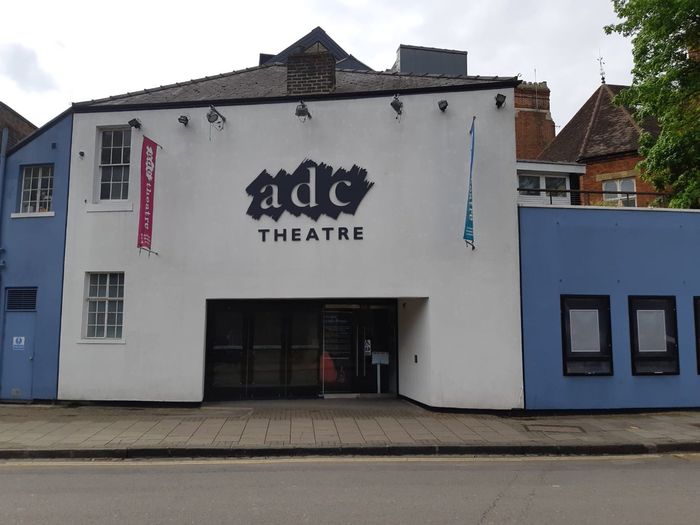A Broadway Ballet
In the third of her series on dance in the time of Covid, Ellie Hunt turns to An American in Paris. Can Christopher Wheeldon deliver on the promise of its concept?

I first watched the 1951 MGM classic An American in Paris the summer before going on my year abroad. It’s a glitzy parade through Paris’ tourist hotspots in a softer, far more magical reality than our own… so it didn’t help to prepare me much. The most realistic part of it all was the opening scene in Kelly’s compact Montmartre apartment – although I can’t say I moved around my own Parisian shoebox-studio with the same dexterity and grace, and I certainly wasn’t brought fresh croissants every morning by my landlord.
“With an easy, spoken narrative and familiar songs, this is a show that provides a wonderful starting point for those curious about ballet and all its storytelling potential”
This Vincente Minnelli musical tells the story of WWII veteran Jerry Mulligan who decides to stay in Paris and become an artist rather than returning to America after the war. There he meets another expat – a sardonic but ultimately endearing pianist named Adam – and falls in love with Lise, an enchanting Parisienne. Unfortunately, she just so happens to be romantically involved with Jerry’s other new friend, Henri, a cabaret singer. Meanwhile, in a bid to further his artistic career, Jerry is pursued by wealthy heiress Milo, completing this complicated chain of unrequited affections. The film continues to inspire today. It is an obvious choice for a stage adaptation, and I was delighted to see it featured in Andrew Lloyd Webber’s ’The Shows Must Go On’ campaign during lockdown. With an easy, spoken narrative and familiar songs, this is a show that provides a wonderful starting point for those curious about ballet and all its storytelling potential.
Christopher Wheeldon made his directorial debut bringing An American in Paris to the stage, and he entrusted Leanne Cope, First Artist of the Royal Ballet, with the role of Lise. Cope is the perfect stage incarnation of Leslie Caron’s playful coyness. However, it is Robbie Fairchild, Principal Dancer with the New York City Ballet, who carries the show as Jerry Mulligan. He brings charm and athleticism rivalling Kelly and is utterly convincing as the dreamer lured to the City of Lights by the exciting, rose-tinted promise of la vie bohème.

Wheeldon was also the show’s choreographer. Adaptations to the story, such as the addition of a fictional ballet company, allowed him to flex his choreographic muscles. The original narrative was a flimsy wire frame over which was draped a gorgeous score by George and Ira Gershwin, including iconic tracks like ‘S’Wonderful’ and ‘I Got Rhythm’. But the stage adaptation is much more than a sickly-sweet jukebox musical: Milo finances a ballet that Lise stars in; Adam and Jerry help compose and design this ballet respectively; Henri is not a successful cabaret artist, but an aspiring one, secretly hiding this dream from his strait-laced parents.
The stage adaptation also tries to nuance the pristine Paris painted on the MGM sets. Jerry confesses to Lise that he wants to forget his traumatic memories of the war, and Adam has a limp that he doesn’t want to ‘parade’ in front of his family. One of the opening visuals is a swastika flag that transforms into a French tricolour; in the streets we see breadlines and the accusations of collaborators; women wait for soldiers to return and fear they will not; a man with a gun leaps through crowds of people dancing in the streets, linking his arms through someone else’s to form a sudden swastika.

The ‘I’ve Got Beginner’s Luck’ sequence in the Galeries Lafayette is an exhibition of designer Bob Crowley’s genius: umbrellas, mannequins, hats, shops counters and rolls of fabric lend the number an excitement that spills off the stage, inviting the audience into this fantasy Paris. His shape-shifting sets highlight Jerry’s artistic ambitions by referencing several quintessential artists of the French canon: Degas’ ballet sketches influence in the ballet audition and rehearsal sets; Renoir and Monet’s impressionist strokes colour the early cityscapes and dance moonlight over Jerry and Lise’s stunning stolen duets by the Seine; the visuals of Picasso and Matisse inspire the final ballet performance and Jerry’s paintings.
However, one of the major problems in the original material that the stage adaptation cannot shake is the treatment of women, particularly Lise. Despite being the centrepiece of the film, she has little to no agency and very few lines of dialogue. She is depicted as an enigma who inspires protection, and she is constantly in a position where men expect her to owe them love. Lise is expected to give Henri her favour because his family protected her, a Jewish woman, from the Nazis during the war; she should return Adam’s affections because he composed the score for the new ballet she stars in, immortalising her in music; she should love Jerry simply because of his persistence.
“Lise is presented as a mere object of desire, a prize for the male leads who vie for her affection”
I couldn’t help but be irked by Jerry’s pursuit of Lise. On the face of it, she is stalked through Paris and harassed at work. Lyrics such as “when you belong to me” only add to my discomfort. One that I found particularly rich was “I’ll even overlook her English”, despite only two or three shockingly poor attempts to speak French being made by the Americans. Her wartime backstory feels like the addition that it is, not given nearly enough space or weight. Lise is presented as a mere object of desire, a prize for the male leads who vie for her affection – of which there are now three instead of the original two, as Adam also falls under her spell.
I felt this ‘love square’ to be an unnecessary transformation; I enjoyed Adam’s original comedically knowing position in the film, stuck between his two friends, aware of the mess they are in and unsure of how to tell them. Yet any discomfort we might have about Jerry and Lise’s relationship melts away every time they dance together. Nowhere is this more evident than in the extended ballet sequence: the searing strings and the heady brass elevate the emotion to intoxicating levels as they recount their whole courtship through dance. Fairchild’s unique movements – a flirtation of ballet and jazz – are an absolute delight to watch.
“[The balletic finale] practically glistens with the magic of golden-age Hollywood; every few minutes we are transported into a new art style and painting that comes alive around our two lovers”
For all the stage show’s beauty, the vibrant, decadent world of the film’s balletic finale, unfettered by the constraints of live performance, remains unrivalled. Almost 20 minutes long, this dialogue-free sequence contains some of the most beautiful shots in cinema. It practically glistens with the magic of golden-age Hollywood; every few minutes we are transported into a new art style and painting that comes alive around our two lovers. The tenderness of the silhouetted, foggy fountain scene can make even the coldest heart ache from the sheer romance of it all. The brief flower market scene is perhaps my favourite, despite being only a couple of moments long. The visuals are breathtaking, and I can’t help but notice how Jerry holds Lise – almost mimicking Siegfried’s embrace of Odette in Swan Lake.
With Wheeldon at the helm of the show and two professional ballet dancers in the lead roles, dance plays a central role in the narrative’s progression. It is allowed to shine as its own language of intimacy and romance, and it is not just relegated to the ornamental or the odd ensemble number. An American in Paris was an easy lockdown watch, conscious of its own shortcomings, aware of the impossibly high expectations it has to live up to, but unable to find the space to reconcile the two. There is simply not enough space in a 150-minute show to resolve every issue and meet those soaring standards of production quality night after night.
One particular question underpins this adaptation: should art uplift us as a form of escapism, or should it reflect life in its totality, with its darker underbelly and imperfections? For better or worse, it’s clear that this show takes the former as its guiding principle.
 News / Caius mourns its tree-mendous loss23 December 2025
News / Caius mourns its tree-mendous loss23 December 2025 News / Clare Hall spent over £500k opposing busway 24 December 2025
News / Clare Hall spent over £500k opposing busway 24 December 2025 Comment / Yes, I’m brown – but I have more important things to say22 December 2025
Comment / Yes, I’m brown – but I have more important things to say22 December 2025 Comment / The ‘class’ of Cambridge24 December 2025
Comment / The ‘class’ of Cambridge24 December 2025 Interviews / Politics, your own way: Tilly Middlehurst on speaking out21 December 2025
Interviews / Politics, your own way: Tilly Middlehurst on speaking out21 December 2025








